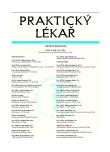Making general practitioner’s work easier by means of the foramlized Czech hypertension quidelines
Authors:
J. Peleška
Authors‘ workplace:
3. interní klinika 1. LF a VFN, Praha
; Centrum biomedicínské informatiky, Ústav informatiky AV ČR, v. v. i., Praha
; Ředitelka: prof. RNDr. Jana Zvárová, DrSc.
; Přednosta: prof. MUDr. Štěpán Svačina, DrSc., MBA
Published in:
Prakt. Lék. 2009; 89(7): 382-388
Category:
Of different specialties
Overview
Simplification of diagnostic and treatment procedures in frame of the current hypertension guidelines for primary care (GL) and simultaneous using a transferable experience of a hypertension specialist should save time. A GP should use the saved time to improve communication with a patient to achieve his (her) more intensive cooperation in diagnostics and treatment for hypertension. This means mainly home blood pressure measurement.
Within 3 months (at maximum) every hypertensive (those with low cardiovascular risk included) is to start pharmacotherapy using drugs with the highest protection against organ damage and evidence – ACE-inhibitors. If they are not tolerated, it is necessary to change them for angiotensin II receptor type 1 blockers (ARB).
Calcium channel blockers (CCB) are suitable as the second drug into combination therapy. CCB and the previous two drug classes are also the best-tolerated ones.
The third drug for a triple therapy should be a thiazide diuretic in a small dose, if need be substituted with indapamide or metipamide.
Due to a deficit in hypertension control it is more realistic to achieve at least the usual goal BP values in most hypertensives and to treat them simultaneously for other associated risk factors dyslipidemia and diabetes.
The formalization of GL by means of the graphic GLIF model could help to improve the control of hypertension. Besides depicting the logical structure of GL decision algorithm it enables an easy calculation of the total cardiovascular risk according to the SCORE project, evaluation of the recommended subclinical organ damages and quick finding of a suitable monotherapy and combination therapy based on entered data of a patient.
Key words:
hypertension control in primary care, hypertension guidelines, algorithm of hypertension specialist, home BP measurement
Sources
1. Cífková, R. Výsledky velkých klinických studií, Studie Accomplish. Hypertenze, bulletin České společnosti pro hypertenzi 2009, 12, 1, s. 10-13.
2. Clement, D.L. How blood pressure control has evolved and why it‘s stagnating. E-Journal of Cardiology Practice 19 May 2008, 6, (34). www.escardio.org/knowledge/cardiology_practice/ejournal_vol6/vol6n34.htm.
3. Filipovský, J. Domácí měření krevního tlaku. In: Widimský jr. J a kol. Arteriální hypertenze – současné klinické trendy, VI. sympozium – sborník přednášek. Praha: Triton, 2008, s. 107–113.
4. Jozífová, M., Cífková, R., Škodová, Z. a kol. Porovnání léčby hypertenze a rizikového profilu hypertoniků v obecné populaci a na specializovaném pracovišti. Cor Vasa 2003, 45, s. 533–541.
5. Karen, I., Widimský, J. jr. Doporučení diagnostických a léčebných postupů u arteriální hypertenze, 2. aktualizované vydání 2008, Doporučený diagnostický a léčebný postup pro všeobecné praktické lékaře. Centrum doporučených postupů pro praktické lékaře. WWW: <http://www.svl.cz/Files/ nastenka/page_4771/Version1/hypertenze.pdf>
6. Manolis, A.J., Doumas, M., Viigimaa, M. et al. Hypertension and sexual dysfunction. European Society of Hypertension Scientific Newsletter: Update on Hypertension Management 2007, 8, (32). http://www.eshonline.org/education/newsletter/2007_32_sexual_dysfunction.pdf
7. O’Brien, E., Asmar, R., Beilin, L. et al. On behalf of the European Society of Hypertension Working Group on Blood Pressure Monitoring. Practice guidelines of the European Society of Hypertension for clinic, ambulatory and self blood pressure measurement. Journal of Hypertension 2005, 23, p. 697–701.
8. Peleška, J. Špatně léčená hypertenze. Kazuistiky v diabetologii 2004, 2, s. 33–36.
9. Peleška, J., Anger, Z., Buchtela, D. a kol. Formalizace lékařských doporučení. EJBI: European Journal for Biomedical Informatics [on line], ISSN 1801-5603, 2005, roč.1, s. 140-147 WWW: http://www.ejbi.org/articles/2005/list.html
10. Peleška, J. Domácí měření krevního tlaku. Med. pro praxi 2006, 3, s.111–114. http://www.medicina- propraxi.cz/magno/med/2006/mn3.php
11. Peleška, J. Jak zlepšit kontrolu hypertenze v primární péči? Med. pro praxi 2008, 5, 9, s. 296–298. http://www.medicinapropraxi.cz/ artkey/med-200809-0002.php
12. Pickering, T.G., Miller, N.H., Ogedegbe, G. et al. Call to Action on Use and Reimbursement for Home Blood Pressure Monitoring: Executive Summary. A Joint Scientific Statement From the American Heart Association, American Society of Hypertension, and Preventive Cardiovascular Nurses Association Hypertension 2008, 52, p 10–29.
Labels
General practitioner for children and adolescents General practitioner for adultsArticle was published in
General Practitioner

2009 Issue 7
Most read in this issue
- Regional migratory osteoporosis – a differential diagnostic problem
- Professional misconduct and errors in medical practice
- Treatment of cannabis dependence
- Prevention of arterial thrombosis (arteriothromboprophylaxis) in clinical practice
